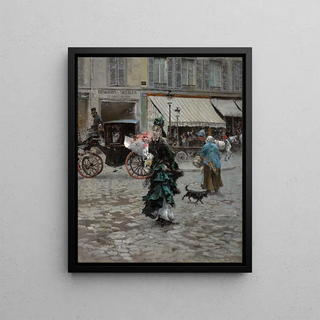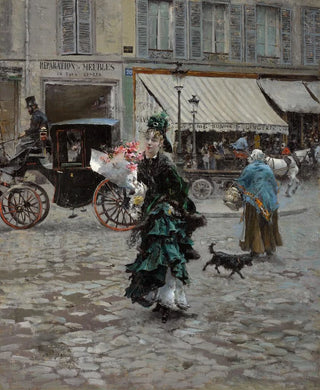Art print | Crossing the street - Giovanni Boldini


View from behind

Frame (optional)
Traversing the street - Giovanni Boldini – Captivating introduction
In the vast panorama of art history, some works manage to capture the essence of an era with such intensity that they transcend time. "Traversing the street" by Giovanni Boldini is one of these creations. This canvas, vibrant and full of life, transports us to Paris during the Belle Époque, a moment when elegance and movement blend in a visual dance. Boldini, master of portraiture, succeeds in capturing not only the features of his subjects but also the atmosphere of a city in full effervescence. The art print of this work allows you to relive this fascinating era while offering a window into the exceptional talent of this artist.
Style and uniqueness of the work
Boldini's style is immediately recognizable, characterized by fluid brushstrokes and vibrant colors. In "Traversing the street," he uses warm tones to evoke Parisian light, while the figures seem almost to float on the canvas, animated by subtle movement. The composition is skillfully orchestrated, with dynamic lines guiding the eye through the scene. This painting does not merely depict a frozen moment; it manages to evoke a sense of life, movement, and even imminence. The characters, dressed in refined costumes, appear to be engaged in conversation, capturing the spirit of conviviality and sophistication of their time. Boldini succeeds in immortalizing not only the appearance of his subjects but also their essence, creating a work that resonates deeply with the viewer.
The artist and his influence
Giovanni Boldini, born in Italy, established himself in Paris as one of the most prominent portraitists of his time. His style, influenced by the Impressionist movement, is distinguished by its ability to combine technique and expressiveness. Boldini was a keen observer of Parisian society, and his works reflect an era where art and fashion intertwined. His painting technique, which favors light and movement, influenced many contemporary and later artists. By incorporating elements of daily life into his portraits, he paved the way for a new approach to portraiture, more lively

Matte finish

View from behind

Frame (optional)
Traversing the street - Giovanni Boldini – Captivating introduction
In the vast panorama of art history, some works manage to capture the essence of an era with such intensity that they transcend time. "Traversing the street" by Giovanni Boldini is one of these creations. This canvas, vibrant and full of life, transports us to Paris during the Belle Époque, a moment when elegance and movement blend in a visual dance. Boldini, master of portraiture, succeeds in capturing not only the features of his subjects but also the atmosphere of a city in full effervescence. The art print of this work allows you to relive this fascinating era while offering a window into the exceptional talent of this artist.
Style and uniqueness of the work
Boldini's style is immediately recognizable, characterized by fluid brushstrokes and vibrant colors. In "Traversing the street," he uses warm tones to evoke Parisian light, while the figures seem almost to float on the canvas, animated by subtle movement. The composition is skillfully orchestrated, with dynamic lines guiding the eye through the scene. This painting does not merely depict a frozen moment; it manages to evoke a sense of life, movement, and even imminence. The characters, dressed in refined costumes, appear to be engaged in conversation, capturing the spirit of conviviality and sophistication of their time. Boldini succeeds in immortalizing not only the appearance of his subjects but also their essence, creating a work that resonates deeply with the viewer.
The artist and his influence
Giovanni Boldini, born in Italy, established himself in Paris as one of the most prominent portraitists of his time. His style, influenced by the Impressionist movement, is distinguished by its ability to combine technique and expressiveness. Boldini was a keen observer of Parisian society, and his works reflect an era where art and fashion intertwined. His painting technique, which favors light and movement, influenced many contemporary and later artists. By incorporating elements of daily life into his portraits, he paved the way for a new approach to portraiture, more lively






